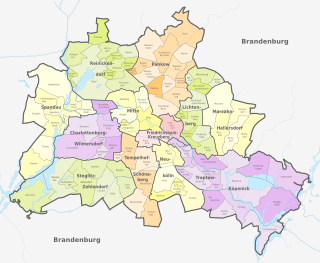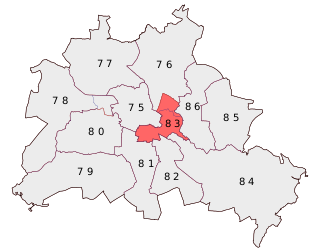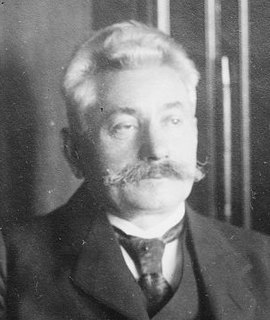| Bust of Carl Legien | |
|---|---|
 The bust in 2016 | |
 | |
| Subject | Carl Legien |
| Location | Kreuzberg, Berlin, Germany |
A bust of Carl Legien is installed along Legiendamm in Kreuzberg, Berlin, Germany.
| Bust of Carl Legien | |
|---|---|
 The bust in 2016 | |
 | |
| Subject | Carl Legien |
| Location | Kreuzberg, Berlin, Germany |
A bust of Carl Legien is installed along Legiendamm in Kreuzberg, Berlin, Germany.

Kreuzberg is a district of Berlin, Germany. It is part of the Friedrichshain-Kreuzberg borough located south of Mitte. During the Cold War era, it was one of the poorest areas of West Berlin, but since German reunification in 1990 it has become more gentrified and known for its arts scene.

Friedrichshain-Kreuzberg is the second borough of Berlin, formed in 2001 by merging the former East Berlin borough of Friedrichshain and the former West Berlin borough of Kreuzberg. The historic Oberbaum Bridge, formerly a Berlin border crossing for pedestrians, links both districts across the river Spree as the new borough's landmark.

Pankow is the most populous and the second-largest borough by area of Berlin. In Berlin's 2001 administrative reform it was merged with the former boroughs of Prenzlauer Berg and Weißensee; the resulting borough retained the name Pankow. Pankow was sometimes claimed by the Western Allies to be the capital of the German Democratic Republic, while the German Democratic Republic itself considered East Berlin to be its capital.

Carl Wilhelm Borchardt was a German mathematician.

Friedrichshain is a quarter (Ortsteil) of the borough of Friedrichshain-Kreuzberg in Berlin, Germany. From its creation in 1920 until 2001, it was a freestanding city borough. Formerly part of East Berlin, it is adjacent to Mitte, Prenzlauer Berg, Kreuzberg and Lichtenberg.

Berlin is both a city and one of Germany’s federated states. Since the 2001 administrative reform, it has been made up of twelve districts, each with its own administrative body. However, unlike the municipalities and counties of other German states, the Berlin districts are not territorial corporations of public law (Gebietskörperschaften) with autonomous competencies and property, but simple administrative agencies of Berlin's state and city government, the City of Berlin forming a single municipality (Einheitsgemeinde) since the Greater Berlin Act of 1920. Thus they cannot be equated to US or UK boroughs in the traditional meaning of the term.

Özcan Mutlu in Kelkit, Gümüşhane Province, Turkey, is a Kurdish-German politician of the Green Party.

Friedrich Wilhelm Jähns was a German music scholar, voice teacher, and composer. He is best known for his chronological catalog of the works of Carl Maria von Weber.
The International Secretariat of National Trade Union Centres (ISNTUC), often simply referred to as the International Secretariat and later renamed the International Federation of Trade Unions (IFTU), was an international consultative body of trade unions. Founded in 1901, it broke apart and became defunct during the First World War.

Berlin-Friedrichshain-Kreuzberg – Prenzlauer Berg East is an electoral constituency represented in the Bundestag. It elects one member via first-past-the-post voting. Under the current constituency numbering system, it is designated as constituency 83. It is located in central Berlin, comprising the Friedrichshain-Kreuzberg borough.

Trinity Church (Dreifaltigkeitskirche) was a Baroque Protestant church in Berlin, eastern Germany, dedicated to the Holy Trinity. It was opened in August 1739 and destroyed in November 1943, with its rubble removed in 1947.

Carl Legien was a German unionist, moderate Social Democratic politician and first President of the International Federation of Trade Unions.
The General German Trade Union Federation was a confederation of German trade unions in Germany founded during the Weimar Republic. It was founded in 1919 and was initially powerful enough to organize a general strike in 1920 against a right-wing coup d'état. After the 1929 Wall Street crash, the ensuing global financial crisis caused widespread unemployment. The ADGB suffered a dramatic loss of membership, both from unemployment and political squabbles. By the time the Nazis seized control of the government, the ADGB's leadership had distanced itself from the Social Democratic Party of Germany (SPD) and was openly cooperating with Nazis in an attempt to keep the organization alive. Nonetheless, on May 2, 1933, the SA and SS stormed the offices of the ADGB and its member trade unions, seized their assets and arrested their leaders, crushing the organization.

Indischer Brunnen is a fountain at Luisenstädtischer Kanal in Kreuzberg, Berlin, Germany.

Leuschnerdamm is a street in Kreuzberg, Berlin, Germany.

Legiendamm is a street in Berlin, Germany. The street is parallel to Leuschnerdamm and borders an accumulation pond of the former Luisenstadt Canal. It is named after Carl Legien and was previously called as Luisenufer. Notable features include Markthalle VII and a bust of Carl Legien.

A bust of Wilhelm Leuschner is installed along Leuschnerdamm in Kreuzberg, Berlin, Germany.
Franz Hillinger was an architect of the Neues Bauen movement in Berlin and in Turkey.
The Stinnes–Legien Agreement was an accord concluded by German trade unions and industrialists on 15 November 1918. Named after both parties' negotiators in chief, heavy industry magnate Hugo Stinnes and union leader Carl Legien, the agreement enshrined a set of workers' rights long coveted by the German labour movement.